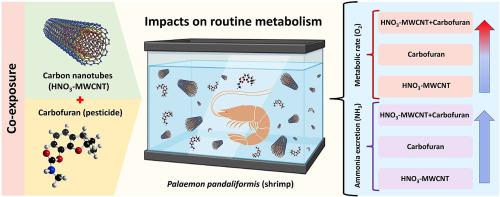Chemosphere ( IF 8.8 ) Pub Date : 2021-09-24 , DOI: 10.1016/j.chemosphere.2021.132359 Kelison Venício Brito Alves 1 , Diego Stéfani T Martinez 2 , Oswaldo L Alves 3 , Edison Barbieri 4

|
Palaemon pandalirformis (shrimp) is a species widely distributed in the Brazilian coastal region and with an important economic role. In addition, this organism is considered an indicator of environmental pollution in estuaries; however, its physiological responses to toxic environmental pollutants, including pesticides and nanomaterials, are not well known, mainly, the effects of co-exposure. Thus, the purpose of this study was to evaluate the ecotoxicological effects of co-exposure between oxidized multiwalled carbon nanotubes (HNO3-MWCNT) and carbofuran pesticide on the routine metabolism of P. pandalirformis. The shrimps were exposed to different concentrations of HNO3-MWCNT (0; 10; 100; 500; 1000 μg L−1), carbofuran (0; 0.1; 1.0; 5.0; 10 μg L−1) and to co-exposure with 100 μg L−1 of HNO3-MWCNT + carbofuran (0; 0.1; 1.0; 5.0; 10 μg L−1), to evaluate the effects on metabolic rate (O2 consumption) and excretion of ammonia (NH4+NH3). Our results showed that the shrimps exposed to HNO3-MWCNT (10 μg L−1) increased the metabolic rate by 292% and the excretion of ammonia by 275%; those exposed to carbofuran (10 μg L−1) increased their metabolic rate by 162% and the excretion of ammonia by 425%; and with the co-exposure of HNO3-MWCNT + carbofuran there was also an increase in the metabolic rate by 317% and an excretion of ammonia by 433% when compared to control. These findings provides useful information toward better understanding the physiological responses of shrimps after combined exposure to nanomaterials and pesticides in aquatic environments.
中文翻译:

碳纳米管与呋喃丹杀虫剂的共同暴露影响Palaemon pandaliformis(虾)的代谢率
Palaemon pandalirformis(虾)是一种广泛分布于巴西沿海地区的物种,具有重要的经济作用。此外,这种生物被认为是河口环境污染的指标;然而,它对有毒环境污染物(包括杀虫剂和纳米材料)的生理反应尚不清楚,主要是共同暴露的影响。因此,本研究的目的是评估氧化多壁碳纳米管 (HNO 3 -MWCNT) 和呋喃丹杀虫剂共同暴露对P. pandalirformis常规代谢的生态毒理学影响。虾暴露于不同浓度的 HNO 3 -MWCNT (0; 10; 100; 500; 1000 μg L -1)、呋喃丹 (0; 0.1; 1.0; 5.0; 10 μg L -1 ) 并与 100 μg L -1的 HNO 3 -MWCNT + 呋喃丹 (0; 0.1; 1.0; 5.0; 10 μg L -1 ) 共同暴露),评估对代谢率(O 2消耗)和氨排泄(NH 4 +NH 3)的影响。我们的结果表明,暴露于 HNO 3 -MWCNT (10 μg L -1 )的虾的代谢率提高了 292%,氨的排泄量提高了 275%;接触克百威(10 μg L -1)的人代谢率提高了162%,氨的排泄量提高了425%;并与 HNO 3共同暴露与对照相比,-MWCNT + 呋喃丹的代谢率也增加了 317%,氨的排泄量增加了 433%。这些发现为更好地了解虾在水生环境中同时接触纳米材料和杀虫剂后的生理反应提供了有用的信息。


























 京公网安备 11010802027423号
京公网安备 11010802027423号